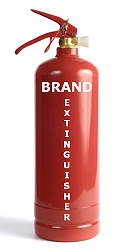Brand Extinguisher
Imagine a successful standup comedian repeating a routine that, the previous night, elicited puzzled looks and muted chuckles from the audience. You can’t. He’d immediately massage his message, tweak his tempo, and punctuate his punchlines until the audiences roar — and subsequently convert their friends into his paying fans.
Branding is based on the same principle as performing: continuously testing & tweaking the marketing message (brand) until it resonates in 15 seconds with customers, reporters, and investors, who react by purchasing, writing about, and investing in the underlying product and/or company, respectively — and encouraging their colleagues to do likewise.
The key principle of success outlined above: always be branding. The recent JCPenney saga provides a great example of a company that ignored this principle.
|
In 2011, Ron Johnson left Apple to take the helm at JCPenney, which had become staid and stationary: its 2010 revenues of $17.8B were below the nearly $20B realized four years earlier. Johnson immediately converted JCPenney into JCP, a flashy, upscale boutique store — and replaced undecipherable discounting with fair/square, always-low pricing. Problem: existing customers didn’t like JCP. No doubt, Johnson had to shake up the retail chain and needed a new breed of customer who would appreciate his changes. Reality: the “desired” customer resisted shopping at JCPenney, even with a new name JCP; traditional customers fled in droves. It’s impossible to execute an overnight, wholesale replacement of current customers with better ones. Sales dropped 25% in Johnson’s first 12 months. Five months later, the board fired him and brought back the CEO he had replaced 17 months before — a nonsolution. Bottom line: Johnson never took the required time to test and tweak Penney’s new brand until it resonated with the new customer. He could have begun his rebranding by instituting always-low pricing without the hipster JCP moniker. A comedian like Frank Caliendo, known and liked for doing voices and impressions, can’t suddenly switch to derisive political humor and expect his current audience to approve. |
 Recently, I attended a medical-technology event, whose exhibit floor featured 140 vendors. As I walked from booth to booth, I read and heard nothing but jargonized, product-centric messages. This is typical, by the way, and the antithesis of branding. When I asked booth personnel what makes their companies unique, vis-a-vis their competitors, they answered with more jargon, akin to using a brand extinguisher. If they don’t know what makes their companies unique, how can customers or reporters or investors know?
Recently, I attended a medical-technology event, whose exhibit floor featured 140 vendors. As I walked from booth to booth, I read and heard nothing but jargonized, product-centric messages. This is typical, by the way, and the antithesis of branding. When I asked booth personnel what makes their companies unique, vis-a-vis their competitors, they answered with more jargon, akin to using a brand extinguisher. If they don’t know what makes their companies unique, how can customers or reporters or investors know?
People buy value solutions, not products and technologies. Yet, with rare exception, vendors endlessly pitch products and technologies, hoping to cheat immutability. This disconnect between branding that makes people react/remember/repeat and the cryptic argot that vendors unfailingly spew to them is enormous.
Poor branding — which needlessly increases the costs of sales, media, and capital — is a big, universal problem that few execs want to fix. HINT: poor branding always includes jargon-laced, functional descriptions of products and gratuitous technology hype.
Corporate Breathing
I know in advance, before discussing branding with CEOs, the excuses they’ll give me for avoiding or delaying the topic. These branding-avoidance excuses are both alarming and comical:
- We’re too busy for that
- Our company is too small
- It’s not a priority right now
- It’s too expensive
- We did that last year.
Let me get this straight: communicating one’s message crisply and memorably to prospects, reporters, and investors is something to avoid? Really? Is our comedian too busy to sharpen his unsuccessful routine? Is this not a priority for him? Is he too “small” to worry about it? Is it too expensive for him to fix his routine? Did he fix it last year?
In fact there’s no excuse for avoiding or delaying branding. Do you avoid breathing? Not if you want to live. Branding is corporate breathing; without it, the other systems malfunction.
Inviolable rule: always be branding. Not never be branding. Not sometimes be branding. Not branding when & if we get around to it. Not branding when our company is larger. Not branding when we can afford it. Not waiting for our branding season.
The bedrock slogan of sales training is: always be closing. It means that the one armed with a solution to a problem should be on perpetual alert for those who need his solution, so he can persuade them to purchase it. Successful closing requires two sets of skills: deftness in prospect qualification, psychology, and persuasion; ability to articulate the product’s value in the prospect’s language. Ironically, the same CEOs who avoid branding would fire salesreps who aren’t continuously closing.
Often, a salesrep possesses neither the technique nor the content of closing: her technique is transparently pushy, her content cloudy. Predictable outcome: “the close” will fail or drag on, needlessly raising the cost of sales. Is this happening in your company?
With training, her technique (qualification, psychology, and persuasion) can improve. What about the content, the value proposition? If your company has a cloudy brand, she’ll have to wing it. What that means, most likely, is torturing your customers with technology hype and jargon-laced, functional descriptions of your products — the opposite of what succeeds.
Rx from the WhiteNoise Doctor™
Look objectively at your branding platforms: homepage, brochures, tradeshow booth, 10K, S-1, annual report, executive summary, keynotes, sales training, sales pitches, etc. Are they rife with jargon, technology hype, product worship? If so, you’re not branding.
Customers, reporters, and investors are deluged with white noise. To them, the plethora of vendors and products are generic. This is bad news for vendors, yet they perpetuate white noise by cranking up the vernacular volume. Why? Because real communication is a lost art. We live in a, like, culture that, like, believes texting is, like, OMG, communicating and posting photos on Facebook is, like, being social. LOL.
People laugh at comedians’ jokes when: 1) they identify personally with the jokes, 2) the jokes are unique and clever, and 3) the jokes are delivered memorably. Customers don’t identify personally with jargon, jargon isn’t unique or clever, and one can’t deliver jargon memorably.
Once again, branding is articulating a unique value proposition, within 15 seconds, so that customers, reporters, and investors react to, remember, and repeat it. Branding is not an extracurricular exercise. Branding is your number #1 priority, your continuous obligation.
If you want your salesreps to “always be closing,” you must always be branding.
© 2013 Marc H. Rudov. All Rights Reserved.
About the Author

Marc Rudov is a branding advisor to CEOs,
producer of MarcRudovTV, and author of four books

